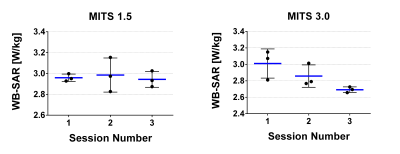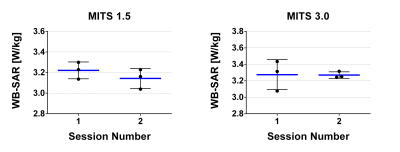1465
Estimated Measurement Uncertainty (EMU) in Calorimetrically-Determined Whole Body SAR Values for Medical Device Evaluation Using Benchtop Radiofrequency Exposure SystemsKrzysztof Wawrzyn1, Jack Hendriks1, William B. Handler1, and Blaine A. Chronik1
1The xMR Labs, Department of Physics and Astronomy, Western University, London, ON, Canada
Synopsis
The in vitro assessment of true radiofrequency whole body averaged specific absorption rate (WB-SAR) is described in the technical specification standard of ASTM F2182-11a, by direct measure of RF-induced heating within a standardized phantom centered inside the RF birdcage coil. F2182-11a does not address uncertainty assessment of the heating experiment. In this study, we present our measured values for short-term measurement repeatability and long-term measurement reproducibility. These measurements support the conclusion that RF-induced WB-SAR measurements made with bench-top RF exposure systems can be made with a total estimated measurement uncertainty of approximately 7% (k=1).
INTRODUCTION
The in vitro assessment of true radiofrequency whole body averaged specific absorption rate (WB-SAR) is described in the technical specification standard of ASTM International F2182-11a, by direct measure of RF-induced heating within a standardized phantom centered inside the RF birdcage coil [1]. For the characterization of MR-conditional medical devices, the WB-SAR value is used to determine the effective exposure level and to normalize the heating results of devices under test. Because the WB-SAR value associated with a device heating measurement factors directly into the final labeling conditions, it is of paramount importance to continually characterize and understand the uncertainty in the WB-SAR measurement. F2182-11a does not address uncertainty assessment of the heating experiment. In this study, we present our measured values for short-term measurement repeatability (repeated measurements within a single session) and long-term measurement reproducibility (across multiple sessions).METHODS
All calorimetry measurements were performed according to ASTM International F2182-11a [1]. Two different RF bench top exposure systems were used, commercially available as “Medical Implant Testing Systems”, or MITS 1.5 and 3.0, corresponding to frequencies of 64 and 128 MHz [2]. The RF exposure parameters for the MITS 1.5 and 3.0 were (respectively): pulse type = sinc2π, duty cycle = 40 %, pulse repetition rate = 1 kHz, polarization = circular 270 ° & 90 °, frequency = 63.3 & 127.6 MHz, input power = 59.0 & 60.2 dBm, and B1,rms = 2.86 & 4.40 µT in air at coil isocenter. Two different rectangular acrylic phantom containers (42×65×16.5 cm and 42×60×16.5 cm) were filled with saline (2.5 g/L NaCl in distilled water, yielding electrical conductivity of 0.47 S/m +/- 10%), to a fluid height of 9.0 cm, corresponding to a total volume of ~24.5 L. The phantoms were thermally insulated with 1” thick polystyrene foam. The geometric center of the phantom fluid (height of 4.5 cm) was aligned with the geometric center of the MITS. Eleven T1C fiber optic temperature sensors [3] (resolution = 0.1 °C, accuracy = 0.2 °C) were submerged near the isocenter of the fluid to monitor temperature with a calibrated Omniflex signal conditioner [3]. Three (n = 3) repeated measurements of 15-, 20- and 30-minute RF exposure at both 64 and 128 MHz. Measurement repeatability was evaluated within a single session (i.e. same day) by repeating measurement without any changes to the physical setup. Measurement reproducibility was performed on different sessions, separated by approximately 6 months, by replicating the experiment setup (i.e. phantom position, probe placement). The measured temperature change after exposure was converted to a WB-SAR value by using: $$$SAR=c\frac{\triangle T}{\triangle t}$$$ , where c is 4150 J/kg°C (the heat capacity of the phantom material), ∆T is temperature change in °C, and ∆t is RF exposure duration in seconds. A precision calibrated RTD TL1-R thermometer [4] was used to verify the average of the 11 fiber-optic probe temperature measurements.RESULTS AND DISCUSSION
Figure 1 and Figure 2 show the calorimetrically determined WB-SAR using the 65-cm and 60-cm long phantom containers, respectively. The overall WB-SAR value, determined by calorimetry, for the 65 cm long phantom was 2.96 ± 0.09 W/kg and 2.85 ± 0.18 W/kg for MITS 1.5 and MITS 3.0, respectively. The WB-SAR value for the 60 cm-long phantom was measured as 3.18 ± 0.09 W/kg (MITS 1.5) and 3.27 ± 0.12 W/kg (MITS 3.0). The percent error of all measurements was under 7%, the highest being for the 65-cm long phantom in MITS 3.0. There was not a substantial difference between the within-session and the between-session measurement uncertainties. As shown in Figure 3, the difference between multi-probe averaged fiber optic temperature-resolved and RTD thermometer-resolved WB-SAR was 9.6% and 5.0%, for MITS 1.5 and MITS 3.0, respectively.CONCLUSION
These measurements support the conclusion that RF-induced WB-SAR measurements made with bench-top RF exposure systems can be made with a total estimated measurement uncertainty (EMU) of approximately 7% (k=1). Additional data will enable the EMU to be estimated with more confidence.Acknowledgements
The authors would like to thank Ryan Chaddock, Brian Dalrymple, and Frank Van Sas for technical support. This work was funded by NSERC Industrial Research Chairs Program, Ontario Research Fund Research Excellence Program, and Canadian Foundation for Innovation.References
[1] ASTM F2182-11a. [2] (ZMT, Zurich, Switzerland). [3] (Neoptix, Québec, Canada). [4] (ThermoProbe Inc., Pearl, MS USA).Figures

Figure 1: Calorimetrically
determined WB-SAR on 65-cm long ASTM phantom.
Mean WB-SAR (i.e. long-term reproducibility) for all sessions is 2.96 ±
0.09 W/kg and 2.85 ± 0.18 W/kg for MITS 1.5 and MITS 3.0, respectively.

Figure 2: Calorimetrically
determined WB-SAR on 60-cm long ASTM phantom. Mean WB-SAR (i.e. long-term
reproducibility) for all sessions is 3.18 ± 0.09 W/kg and 3.27 ± 0.12 W/kg for
MITS 1.5 and MITS 3.0, respectively.

Figure 3: Calorimetrically
determined WB-SAR on 65-cm long ASTM phantom using fiber optic (circle marker) and RTD thermometer (square marker). For MITS 1.5, WB-SAR is 2.94 ± 0.08 W/kg
(fiber) and 2.67 ± 0.12 W/kg (RTD). For MITS 3.0, WB-SAR is 2.69 ± 0.18 W/kg
(fiber) and 2.56 ± 0.10 W/kg (RTD).